Types of Glasses



Types of Glasses
With various types of glasses, choosing the perfect pair might be overwhelming. This article helps you understand all the different types of glasses, lenses and frames available. Use this as a starting point to see all the options and find the perfect eyewear.
Types of prescription glasses
Firstly, you need to know if you need an eye prescription for your glasses. Whether it’s for reading, working, or leisure, many people need eyeglasses to help correct their vision and see better. Before shopping for a new pair, make sure your eye prescription is still valid, or visit your optometrist for a check-up.
Our eyesight naturally changes as we age, and sometimes it can change while we are still young. These changes can depend on genetics, illnesses, or a misshaped cornea. For each type of refractive error, there is a pair of prescription glasses to help correct it.
Single vision glasses

Single Vision glasses are the most common type of glasses. “Single Vision” means that the lenses only have one type of vision correction, so one focal length. They help correct refractive errors such as myopia, hyperopia and astigmatism, but only for distance or near vision, never both.
Bifocal glasses

Bifocal glasses have lenses with separate prescription zones for near and far vision. At the top, you’ll have your distance correction, while your near vision correction is towards the bottom. These lenses have a distinct line between each value which causes an image to jump when the eye moves from a far distance to a near one. An image jump is when the object appears to jump into view closer than it is when viewing through the near segment.
Progressive glasses

Unlike bifocals, progressive glasses help correct all focal points without visible lines. Each area transitions from one visual correction to another, allowing smoother vision. The top of the lens is adapted for distance vision and gradually increases in power into the intermediate prescription, which corrects anything at an arm’s length away. Finally, it increases in power towards the bottom, designed for reading or other “close-up” tasks, like checking a price tag or using your smartphone.
Other types of glasses
Reading glasses
Reading glasses are a type of single vision lenses, but they do not always require a prescription and are available OTC (over the counter), even at local supermarkets. These do not correct your vision but simply magnify things to make them bigger. They also do not correct astigmatism or amblyopia (a difference of power between the two eyes), so you can only get them in the same power for both eyes (R+L). Reading glasses help you see things close up, like reading a book or looking at your phone or computer.
The power value of reading glasses can start low (+1) and reach higher prescriptions (+4). There are different types of reading glasses which you can read more about here to choose the best one for you. In any case, we recommend consulting your opticians when experiencing visual discomfort before buying any glasses.
Blue Light Glasses
Blue light blocking glasses are designed to filter out the blue light rays commonly released from digital screens. The filter on the surface of these lenses blocks out an estimated 65% of blue light rays. This will help prevent eyestrain symptoms caused by blue light that can irritate the eyes. If you use digital technology for socialising, fun, or work and have noticed changes in your eyes or health, then blue light glasses may be what your eyes need.
Safety Glasses
Safety glasses are available to anyone without any prescription and help protect your eyes from external factors that may hinder your vision. Safety goggles are a must if working in an environment surrounded by hazardous elements, but they can also be used in other contexts for work or leisure.
Sunglasses
Sunglasses are also glasses that we can use with or without a prescription to see better and protect our eyesight. Similar to prescription glasses, sunglasses can also come with various lenses and filters that work best with specific situations. If you’re looking for something practical that combines your glasses and sunglasses or don’t like wearing contact lenses, you may want to consider the following:
Types of lenses for glasses
Depending on a person’s eye needs and preferences, different types of lenses work best with prescription glasses.
- Glass
- Plastic
- Polycarbonate
- Trivex & High trivex
You can also combine many lenses with protective coatings to reduce damage to your eyewear and eyesight. Alongside quality lenses, specific frames are also available for all glasses.
Types of glasses frames
Even frame materials and designs can impact your vision and comfort. Some are heavier than others or even bulkier, while others are more lightweight and look nearly invisible.
Frame types
There are three main types of glasses frames:
- Full-rim: Full-rim frames completely outline the lens. They are the most durable frame type.
- Rimless: Rimless glasses, also known as frameless eyeglasses, are glasses with no frame. The nose bridge connects the lenses, and the temples are directly attached to the lenses. This frame type is the most delicate one.
- Semi-rimless: Semi-rimless frames cover the top part of the lenses.

Frame materials
There are four main types of material used for glasses frames:
- Acetate: Acetate glasses are a low-price option, much like plastic glasses, with the benefits of greater durability and closer related to metal frames.
- Metal: Aside from their elegant aesthetic benefits, metal frame glasses are a durable material that isn’t likely to break easily with proper care.
- Plastic: Plastic is the most affordable option. Plastic frames make for a great second pair of backup glasses. Plastic is also lightweight and resistant to chemical corrosion.
- Titanium: While more expensive than other materials, titanium glasses are the most resistant. They are flexible, hypoallergenic and lightweight for a comfortable fit.
- Wood: Wood frame glasses are durable and resistant as well as eco-friendly. Aside from this, they offer a unique aesthetic quality to add to your style.

Frame shapes
Glasses come in a variety of shapes, and this is excellent news! You can find the one that will emphasise your best features and adapt to the type of prescription you need. Consult this infographic and then read on to learn how to match your face shape with the right frame.

The frame size is also important when choosing the type of glasses you want. If your specs do not fit comfortably on your face, you’ll experience discomfort, such as glasses slipping down or tight frames.
What type of glasses fits my face?
With all these frame types, styles and shapes, there are hundreds of options to choose from. One way to start narrowing down your choices is to determine which face shape you have. Watch this tutorial to find your face shape and which glasses fit you best!
What type of glasses should I get?
Whether you need to read, see distant objects, or look cool, the type of glasses you need depends on your eyes and lifestyle. Firstly, if you need vision correction, make sure your prescription is up to date. Once you have that, read about the best lenses you can get or ask for online advice from one of our opticians.
In this article, we’ve covered the different types of prescription and non-prescription glasses and some tips for choosing the best pair for you. We’ve also introduced the various lens materials, coatings and frames from which prescription glasses and sunglasses can benefit.
Remember that before you buy any prescription glasses, you should have regular eye tests by your optometrist or eye doctor. At SmartBuyGlasses, you can find optical advice and trendy and quality eyewear to satisfy your needs and lifestyle.
Types of Glasses
With various types of glasses, choosing the perfect pair might be overwhelming. This article helps you understand all the different types of glasses, lenses and frames available. Use this as a starting point to see all the options and find the perfect eyewear.
Types of prescription glasses
Firstly, you need to know if you need an eye prescription for your glasses. Whether it’s for reading, working, or leisure, many people need eyeglasses to help correct their vision and see better. Before shopping for a new pair, make sure your eye prescription is still valid, or visit your optometrist for a check-up.
Our eyesight naturally changes as we age, and sometimes it can change while we are still young. These changes can depend on genetics, illnesses, or a misshaped cornea. For each type of refractive error, there is a pair of prescription glasses to help correct it.
Single vision glasses

Single Vision glasses are the most common type of glasses. “Single Vision” means that the lenses only have one type of vision correction, so one focal length. They help correct refractive errors such as myopia, hyperopia and astigmatism, but only for distance or near vision, never both.
Bifocal glasses

Bifocal glasses have lenses with separate prescription zones for near and far vision. At the top, you’ll have your distance correction, while your near vision correction is towards the bottom. These lenses have a distinct line between each value which causes an image to jump when the eye moves from a far distance to a near one. An image jump is when the object appears to jump into view closer than it is when viewing through the near segment.
Progressive glasses

Unlike bifocals, progressive glasses help correct all focal points without visible lines. Each area transitions from one visual correction to another, allowing smoother vision. The top of the lens is adapted for distance vision and gradually increases in power into the intermediate prescription, which corrects anything at an arm’s length away. Finally, it increases in power towards the bottom, designed for reading or other “close-up” tasks, like checking a price tag or using your smartphone.
Other types of glasses
Reading glasses
Reading glasses are a type of single vision lenses, but they do not always require a prescription and are available OTC (over the counter), even at local supermarkets. These do not correct your vision but simply magnify things to make them bigger. They also do not correct astigmatism or amblyopia (a difference of power between the two eyes), so you can only get them in the same power for both eyes (R+L). Reading glasses help you see things close up, like reading a book or looking at your phone or computer.
The power value of reading glasses can start low (+1) and reach higher prescriptions (+4). There are different types of reading glasses which you can read more about here to choose the best one for you. In any case, we recommend consulting your opticians when experiencing visual discomfort before buying any glasses.
Blue Light Glasses
Blue light blocking glasses are designed to filter out the blue light rays commonly released from digital screens. The filter on the surface of these lenses blocks out an estimated 65% of blue light rays. This will help prevent eyestrain symptoms caused by blue light that can irritate the eyes. If you use digital technology for socialising, fun, or work and have noticed changes in your eyes or health, then blue light glasses may be what your eyes need.
Safety Glasses
Safety glasses are available to anyone without any prescription and help protect your eyes from external factors that may hinder your vision. Safety goggles are a must if working in an environment surrounded by hazardous elements, but they can also be used in other contexts for work or leisure.
Sunglasses
Sunglasses are also glasses that we can use with or without a prescription to see better and protect our eyesight. Similar to prescription glasses, sunglasses can also come with various lenses and filters that work best with specific situations. If you’re looking for something practical that combines your glasses and sunglasses or don’t like wearing contact lenses, you may want to consider the following:
Types of lenses for glasses
Depending on a person’s eye needs and preferences, different types of lenses work best with prescription glasses.
- Glass
- Plastic
- Polycarbonate
- Trivex & High trivex
You can also combine many lenses with protective coatings to reduce damage to your eyewear and eyesight. Alongside quality lenses, specific frames are also available for all glasses.
Types of glasses frames
Even frame materials and designs can impact your vision and comfort. Some are heavier than others or even bulkier, while others are more lightweight and look nearly invisible.
Frame types
There are three main types of glasses frames:
- Full-rim: Full-rim frames completely outline the lens. They are the most durable frame type.
- Rimless: Rimless glasses, also known as frameless eyeglasses, are glasses with no frame. The nose bridge connects the lenses, and the temples are directly attached to the lenses. This frame type is the most delicate one.
- Semi-rimless: Semi-rimless frames cover the top part of the lenses.

Frame materials
There are four main types of material used for glasses frames:
- Acetate: Acetate glasses are a low-price option, much like plastic glasses, with the benefits of greater durability and closer related to metal frames.
- Metal: Aside from their elegant aesthetic benefits, metal frame glasses are a durable material that isn’t likely to break easily with proper care.
- Plastic: Plastic is the most affordable option. Plastic frames make for a great second pair of backup glasses. Plastic is also lightweight and resistant to chemical corrosion.
- Titanium: While more expensive than other materials, titanium glasses are the most resistant. They are flexible, hypoallergenic and lightweight for a comfortable fit.
- Wood: Wood frame glasses are durable and resistant as well as eco-friendly. Aside from this, they offer a unique aesthetic quality to add to your style.

Frame shapes
Glasses come in a variety of shapes, and this is excellent news! You can find the one that will emphasise your best features and adapt to the type of prescription you need. Consult this infographic and then read on to learn how to match your face shape with the right frame.

The frame size is also important when choosing the type of glasses you want. If your specs do not fit comfortably on your face, you’ll experience discomfort, such as glasses slipping down or tight frames.
What type of glasses fits my face?
With all these frame types, styles and shapes, there are hundreds of options to choose from. One way to start narrowing down your choices is to determine which face shape you have. Watch this tutorial to find your face shape and which glasses fit you best!
What type of glasses should I get?
Whether you need to read, see distant objects, or look cool, the type of glasses you need depends on your eyes and lifestyle. Firstly, if you need vision correction, make sure your prescription is up to date. Once you have that, read about the best lenses you can get or ask for online advice from one of our opticians.
In this article, we’ve covered the different types of prescription and non-prescription glasses and some tips for choosing the best pair for you. We’ve also introduced the various lens materials, coatings and frames from which prescription glasses and sunglasses can benefit.
Remember that before you buy any prescription glasses, you should have regular eye tests by your optometrist or eye doctor. At SmartBuyGlasses, you can find optical advice and trendy and quality eyewear to satisfy your needs and lifestyle.
BTS Fashion Style With Dynamite Eyewear

Eye Problems
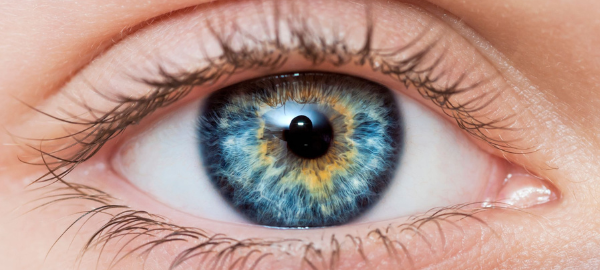

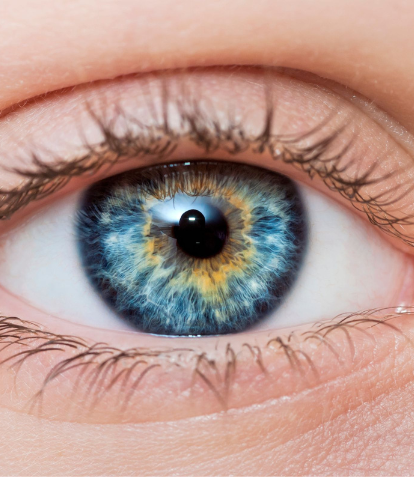
Eye Problems
Most people suffer from eye problems at some point in their lives. Some of the symptoms are minor and will go away independently, while others are simple to treat at home. Others require the attention of an expert.
While many eye issues are not a cause for concern, it is essential to identify the problem in case you need further help. Read on to find which eye problem fits your symptoms and discover the simple home remedies to relieve yourself and improve your eye care.
Why is my eye swollen?

Swelling of the eyelids can be due to inflammation, infection, or trauma. The eye swelling may be the only symptom in some cases, but the eyelid may also be red, itchy, scratchy, or painful. The most prevalent cause of swollen eyes is allergies. Swollen eyes are a symptom of the body’s natural response to allergens and are caused by pollen, dust, pet hair or seasonal changes.
Your eyelids help you a lot. They shield your eye and limit the quantity of light that can enter. That is why it is critical to look after them. So, what could the cause of a swollen eye be? Here are some of the possibilities:
- • Allergy
- • Infection (e.g., Blepharitis)
- • Injury
- • Stye
- • Cosmetics
The cause determines treatment for swollen eyes. Infections require antiviral drugs, anti-inflammatory eye drops, ointments, or antibiotics. Antihistamine drops or oral allergy medicine are usually effective treatments for swollen eyes caused by allergies. You can reduce swelling and soreness by using a cool compress. It’s important not to wipe your eyes or wear contact lenses because this will worsen the situation.
Why do my eyes burn?

Burning eyes are both unpleasant and alarming. In some situations, the reason is apparent, and you can treat the symptoms with over-the-counter medicine. Some causes of burning eyes, however, need expert treatment. Take a look a some of the reasons:
- • Allergens
- • Fragrances
- • Dry eyes
- • Eye sunburn
- • Ocular rosacea (skin condition)
The underlying cause of burning eyes will determine the best way to proceed. If a bacterial infection causes your eyes to burn, your doctor may prescribe antibiotic eye drops to treat the eye issue. However, dry eyes are one of the most prevalent reasons for burning eyes, so relieving that symptom is a good place to start.
The doctor may also recommend avoiding known irritants and cleaning the eyelid edges close to the centre bottom of the eyelashes. Your eyes may also burn from too much screen time. We suggest protecting yourself with blue light glasses that filter out harmful blue light. Also crucially important is having a great pair of sunglasses that offer UV protection.
Why do my eyes keep watering?

When you’re in a smoky environment or outside in the cold or wind, it’s natural for your eyes to water. Your eyes also water if you have an eye injury or something in your eye, such as an eyelash or a piece of dirt. Because their tear ducts are tiny, babies’ eyes frequently water. By the time they’re a year old, things are usually much better.
Here are some possible reasons behind watery eyes:
- • An allergy or infection (e.g., conjunctivitis)
- • Blocked tear ducts
- • Eyelid problems such as ectropion
- • Dry eye syndrome
Dry eye syndrome is one of the most common causes of watery eyes. Dry eyes can cause excessive tear production. Because your eyes aren’t getting enough lubricant, you produce excessive tears.
Your eyes can get excessively dry if your tears do not contain the proper balance of water, salt, and oils. Another suggestion is to drape a warm, damp cloth over your eyes several times daily to aid with blocked tear ducts. For more information, read our article for tips on improving your eye health with diet.
If you find that your main issue is debris or wind entering your eyes when enjoying your favourite sport, look at some protective goggles. There is also the possibility that your prescription glasses need updating. If it’s been a while since you last got your prescription checked, this could be a sign to visit your optician.
Why does my eye hurt when I blink?

When blinking, your entire eye may feel uncomfortable, or specific areas, such as the corner of the eye or the upper eyelid. When debris, such as dirt or sand, gets lodged in the eye, it can cause discomfort when blinking. It can, however, be down to an injury or a medical condition.
Your doctor may need to perform tests or examine if the source of your eye pain isn’t clear. However, a doctor can treat many of the most frequent causes of eye pain with medications. Let’s take a look at common causes of pain when blinking:
- • Astigmatism
- • Blepharitis
- • Cluster headaches
- • Corneal scratches
- • Eye debris
You can use over-the-counter medications or home cures to alleviate symptoms and provide comfort. However, make sure you don’t rely on them to treat any underlying causes of pain, as that’s something you should leave to your doctor.
People with astigmatism can experience pain when blinking if they do not have the correct glasses. Read all you need to know about astigmatism in our article here.
Conclusion

Eye pain is usually only minor and often caused by manageable causes like allergens. If over-the-counter pain relievers, eye drops, or a warm compress don’t relieve your symptoms, you should see a doctor. You should seek emergency medical treatment if your symptoms significantly deteriorate or the number of symptoms increases dramatically in a short period of time.
Eye Problems
Most people suffer from eye problems at some point in their lives. Some of the symptoms are minor and will go away independently, while others are simple to treat at home. Others require the attention of an expert.
While many eye issues are not a cause for concern, it is essential to identify the problem in case you need further help. Read on to find which eye problem fits your symptoms and discover the simple home remedies to relieve yourself and improve your eye care.
Why is my eye swollen?

Swelling of the eyelids can be due to inflammation, infection, or trauma. The eye swelling may be the only symptom in some cases, but the eyelid may also be red, itchy, scratchy, or painful. The most prevalent cause of swollen eyes is allergies. Swollen eyes are a symptom of the body’s natural response to allergens and are caused by pollen, dust, pet hair or seasonal changes.
Your eyelids help you a lot. They shield your eye and limit the quantity of light that can enter. That is why it is critical to look after them. So, what could the cause of a swollen eye be? Here are some of the possibilities:
- • Allergy
- • Infection (e.g., Blepharitis)
- • Injury
- • Stye
- • Cosmetics
The cause determines treatment for swollen eyes. Infections require antiviral drugs, anti-inflammatory eye drops, ointments, or antibiotics. Antihistamine drops or oral allergy medicine are usually effective treatments for swollen eyes caused by allergies. You can reduce swelling and soreness by using a cool compress. It’s important not to wipe your eyes or wear contact lenses because this will worsen the situation.
Why do my eyes burn?

Burning eyes are both unpleasant and alarming. In some situations, the reason is apparent, and you can treat the symptoms with over-the-counter medicine. Some causes of burning eyes, however, need expert treatment. Take a look a some of the reasons:
- • Allergens
- • Fragrances
- • Dry eyes
- • Eye sunburn
- • Ocular rosacea (skin condition)
The underlying cause of burning eyes will determine the best way to proceed. If a bacterial infection causes your eyes to burn, your doctor may prescribe antibiotic eye drops to treat the eye issue. However, dry eyes are one of the most prevalent reasons for burning eyes, so relieving that symptom is a good place to start.
The doctor may also recommend avoiding known irritants and cleaning the eyelid edges close to the centre bottom of the eyelashes. Your eyes may also burn from too much screen time. We suggest protecting yourself with blue light glasses that filter out harmful blue light. Also crucially important is having a great pair of sunglasses that offer UV protection.
Why do my eyes keep watering?

When you’re in a smoky environment or outside in the cold or wind, it’s natural for your eyes to water. Your eyes also water if you have an eye injury or something in your eye, such as an eyelash or a piece of dirt. Because their tear ducts are tiny, babies’ eyes frequently water. By the time they’re a year old, things are usually much better.
Here are some possible reasons behind watery eyes:
- • An allergy or infection (e.g., conjunctivitis)
- • Blocked tear ducts
- • Eyelid problems such as ectropion
- • Dry eye syndrome
Dry eye syndrome is one of the most common causes of watery eyes. Dry eyes can cause excessive tear production. Because your eyes aren’t getting enough lubricant, you produce excessive tears.
Your eyes can get excessively dry if your tears do not contain the proper balance of water, salt, and oils. Another suggestion is to drape a warm, damp cloth over your eyes several times daily to aid with blocked tear ducts. For more information, read our article for tips on improving your eye health with diet.
If you find that your main issue is debris or wind entering your eyes when enjoying your favourite sport, look at some protective goggles. There is also the possibility that your prescription glasses need updating. If it’s been a while since you last got your prescription checked, this could be a sign to visit your optician.
Why does my eye hurt when I blink?

When blinking, your entire eye may feel uncomfortable, or specific areas, such as the corner of the eye or the upper eyelid. When debris, such as dirt or sand, gets lodged in the eye, it can cause discomfort when blinking. It can, however, be down to an injury or a medical condition.
Your doctor may need to perform tests or examine if the source of your eye pain isn’t clear. However, a doctor can treat many of the most frequent causes of eye pain with medications. Let’s take a look at common causes of pain when blinking:
- • Astigmatism
- • Blepharitis
- • Cluster headaches
- • Corneal scratches
- • Eye debris
You can use over-the-counter medications or home cures to alleviate symptoms and provide comfort. However, make sure you don’t rely on them to treat any underlying causes of pain, as that’s something you should leave to your doctor.
People with astigmatism can experience pain when blinking if they do not have the correct glasses. Read all you need to know about astigmatism in our article here.
Conclusion

Eye pain is usually only minor and often caused by manageable causes like allergens. If over-the-counter pain relievers, eye drops, or a warm compress don’t relieve your symptoms, you should see a doctor. You should seek emergency medical treatment if your symptoms significantly deteriorate or the number of symptoms increases dramatically in a short period of time.
How Do Glasses Work?



How Do Glasses Work?
Prescription glasses are an everyday necessity for over 60% of our population. The history of these seemingly simple objects is hazy. Some say the earliest pairs of glasses were founded in the 13th century in Italy. Some say that an English Friar designed them. Nonetheless, prescription glasses are an everyday staple that have come a long way in design, trends and comfort. But what are prescription glasses, and what do glasses do to correct our vision?
How do glasses correct vision?
Prescription glasses work by bending the light as it enters your eye. This allows your eyes to focus light on the correct spot of your retina. The retina is a layer of cells in the rear of the eye that reacts to light. This reaction gets sent to the brain, which converts the cell’s actions into pictures. Put simply, glasses work by bending light through the curved lenses and, with the right prescription, manipulate it to reach the correct spot on your retina. The result is a clear, crisp image.

What types of glasses are there?
Of course, not everyone has the same eyesight issues. Depending on your prescription, you need lenses tailored to your specific needs. Images you see don’t focus on the right place of the retina when you have nearsightedness or farsightedness. Nearsightedness causes the image to focus at the front of the retina. Whereas farsightedness causes the image to focus behind the retina.
Other issues, such as astigmatism, occur when the cornea is unevenly shaped, which bends light in different directions. Another common issue is presbyopia which is the gradual loss of the eye’s ability to focus on nearby objects. When getting an eye exam, you’ll learn exactly which type of glasses you need to fit your prescription. But how do glasses differ from each other to correct your vision?
How do prism glasses work?
If you suffer from double vision, prism glasses help align your eyes, allowing you to perceive only one clear picture. The prism in your spectacles bends the light before it reaches your eye. The light is then diverted to the correct location on each eye’s retina. In effect, your brain combines the two pictures to form a single, distinct image.
How do progressive glasses work?
Three prescriptions are combined into one pair of progressive glasses, which help with presbyopia. You can conduct close-up work (like reading a book), middle-distance work (like browsing a website on a computer) and distant viewing (like driving) without changing your glasses. To focus on the different sections of the lens, you simply adjust your head position.
Prism and progressive lenses aren’t the only prescription glasses type. If you want to learn more about how glasses work and the different prescription lenses offered, check out our Optical Centre. Glasses can be a complex topic, and understanding the exact science can take a lot of reading. But by now, you should know the basics of how glasses work and feel more confident when buying your next pair.
For all your prescription glasses needs, shop from our range of designer and affordable glasses. For any questions you might still have, our opticians are ready and available to help with just a few clicks.
How Do Glasses Work?
Prescription glasses are an everyday necessity for over 60% of our population. The history of these seemingly simple objects is hazy. Some say the earliest pairs of glasses were founded in the 13th century in Italy. Some say that an English Friar designed them. Nonetheless, prescription glasses are an everyday staple that have come a long way in design, trends and comfort. But what are prescription glasses, and what do glasses do to correct our vision?
How do glasses correct vision?
Prescription glasses work by bending the light as it enters your eye. This allows your eyes to focus light on the correct spot of your retina. The retina is a layer of cells in the rear of the eye that reacts to light. This reaction gets sent to the brain, which converts the cell’s actions into pictures. Put simply, glasses work by bending light through the curved lenses and, with the right prescription, manipulate it to reach the correct spot on your retina. The result is a clear, crisp image.

What types of glasses are there?
Of course, not everyone has the same eyesight issues. Depending on your prescription, you need lenses tailored to your specific needs. Images you see don’t focus on the right place of the retina when you have nearsightedness or farsightedness. Nearsightedness causes the image to focus at the front of the retina. Whereas farsightedness causes the image to focus behind the retina.
Other issues, such as astigmatism, occur when the cornea is unevenly shaped, which bends light in different directions. Another common issue is presbyopia which is the gradual loss of the eye’s ability to focus on nearby objects. When getting an eye exam, you’ll learn exactly which type of glasses you need to fit your prescription. But how do glasses differ from each other to correct your vision?
How do prism glasses work?
If you suffer from double vision, prism glasses help align your eyes, allowing you to perceive only one clear picture. The prism in your spectacles bends the light before it reaches your eye. The light is then diverted to the correct location on each eye’s retina. In effect, your brain combines the two pictures to form a single, distinct image.
How do progressive glasses work?
Three prescriptions are combined into one pair of progressive glasses, which help with presbyopia. You can conduct close-up work (like reading a book), middle-distance work (like browsing a website on a computer) and distant viewing (like driving) without changing your glasses. To focus on the different sections of the lens, you simply adjust your head position.
Prism and progressive lenses aren’t the only prescription glasses type. If you want to learn more about how glasses work and the different prescription lenses offered, check out our Optical Centre. Glasses can be a complex topic, and understanding the exact science can take a lot of reading. But by now, you should know the basics of how glasses work and feel more confident when buying your next pair.
For all your prescription glasses needs, shop from our range of designer and affordable glasses. For any questions you might still have, our opticians are ready and available to help with just a few clicks.
6 Tips to Improve Your Eye Health
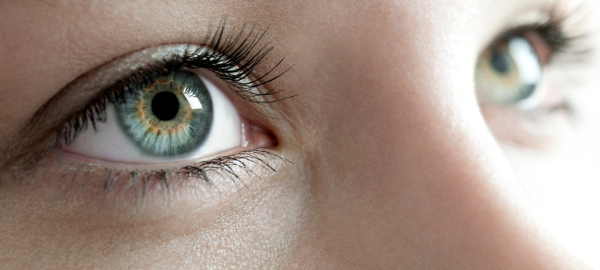


6 Tips to Improve Your Eye Health
Our eyes are perhaps one of our body’s most complex and essential organs. They allow us to see the world by taking in light and sending signals to our brains. As one of the most crucial senses we have, you should never ignore your eye health. With a few simple steps, you can reduce your risk of developing eye diseases, vision loss, and blindness in worst-case scenarios.
Our eyes are perhaps one of our body’s most complex and essential organs. They allow us to see the world by taking in light and sending signals to our brains. As one of the most crucial senses we have, you should never ignore your eye health. With a few simple steps, you can reduce your risk of developing eye diseases, vision loss and blindness in worst-case scenarios.
How to improve eye health
There’s a lot you can do to maintain your eyesight and make sure you have healthy eyes. Regular checkups, such as a dilated eye exam, are at the top of the list for spotting diseases that could put your eyesight in danger. Making sure you see a professional regularly is the best thing you can do. Of course, there are also measures you can take at home to ensure your eyes stay healthy.
Foods for eye health
As simple as it sounds, the food you eat significantly impacts your eye health. Omega-3 fatty acids, lutein, zinc and vitamins C and E can aid in lowering your risk of eye disease as you age. Ensure you are incorporating foods that contain these key nutrients into your diets, such as leafy greens, salmon, tuna, eggs, oranges and other citrus fruit for healthy eyes.
Quit smoking
Smoking doesn’t just cause damage to your lungs. This unhealthy habit can affect your eye health and increase your risk of diseases such as macular degeneration. Although it can be a hard habit to kick, with so many helpful resources, you’ll be making the best decision for your eyes and overall health.
Wear the right sunglasses
Whether it’s summer or winter, our eyes are always subject to the sun’s harmful ultraviolet rays. Wearing proper sunglasses that offer UV protection will help keep your eyesight healthy. When buying a pair of sunglasses, select a good quality pair of polarised sunglasses that you can wear throughout the year.
Keep your eyes clean
If germs or bacteria get inside your eyes, it can lead to an infection with unpleasant symptoms. You could suffer from itching, swelling, discharge, discomfort or vision problems. To prevent this, make sure you keep your makeup brushes clean and that all your products are within their expiry date. If you use contacts, ensure your hands are clean before inserting them and taking them out at night. Even if they’re indicated for long-term use, sleeping with contacts can increase your risk of unhealthy eyes since germs have more time to spread.
Break up screen time
With everyone focused on digital screens all day, taking breaks when you can is essential to allow your eyes to rest. We blink less frequently when staring at TVs, phones or computer screens, which can cause dry eyes, hazy vision and headaches. To break up your screen time, use the 20-20-20 rule: Look 20 feet forward for 20 seconds every 20 minutes. Make sure you read more about how to keep your eyes safe and protect them from digital eye strain.
Eye drops
If you suffer from dry or itching eyes, a helpful tip is to keep eye drops close by for a quick and easy fix. Eye drops can soothe your eyes and flush out any particles or debris that can cause irritation. Make sure you see your optometrist to find out which eye drops are best for you.
Tips for healthy eyes
Taking care of our general health can sometimes feel like a lot of effort with so much going on around us. Luckily, with just a few simple tips, you can have healthy eyes and prevent your eyesight from deteriorating.

SmartBuyGlasses is here to help you buy the best glasses and ensure your eyes and eyesight stay healthy. Now that you know all of our eye care tips and tricks for the best eye health, read our other Optical Centre articles for more information on prescription glasses, sunglasses and contact lenses. You can also ask our opticians any questions or concerns you might still have.
6 Tips to Improve Your Eye Health
Our eyes are perhaps one of our body’s most complex and essential organs. They allow us to see the world by taking in light and sending signals to our brains. As one of the most crucial senses we have, you should never ignore your eye health. With a few simple steps, you can reduce your risk of developing eye diseases, vision loss and blindness in worst-case scenarios.
How to improve eye health
There’s a lot you can do to maintain your eyesight and make sure you have healthy eyes. Regular checkups, such as a dilated eye exam, are at the top of the list for spotting diseases that could put your eyesight in danger. Making sure you see a professional regularly is the best thing you can do. Of course, there are also measures you can take at home to ensure your eyes stay healthy.
Foods for eye health
As simple as it sounds, the food you eat significantly impacts your eye health. Omega-3 fatty acids, lutein, zinc and vitamins C and E can aid in lowering your risk of eye disease as you age. Ensure you are incorporating foods that contain these key nutrients into your diets, such as leafy greens, salmon, tuna, eggs, oranges and other citrus fruit for healthy eyes.
Quit smoking
Smoking doesn’t just cause damage to your lungs. This unhealthy habit can affect your eye health and increase your risk of diseases such as macular degeneration. Although it can be a hard habit to kick, with so many helpful resources, you’ll be making the best decision for your eyes and overall health.
Wear the right sunglasses
Whether it’s summer or winter, our eyes are always subject to the sun’s harmful ultraviolet rays. Wearing proper sunglasses that offer UV protection will help keep your eyesight healthy. When buying a pair of sunglasses, select a good quality pair of polarised sunglasses that you can wear throughout the year.
Keep your eyes clean
If germs or bacteria get inside your eyes, it can lead to an infection with unpleasant symptoms. You could suffer from itching, swelling, discharge, discomfort or vision problems. To prevent this, make sure you keep your makeup brushes clean and that all your products are within their expiry date. If you use contacts, ensure your hands are clean before inserting them and taking them out at night. Even if they’re indicated for long-term use, sleeping with contacts can increase your risk of unhealthy eyes since germs have more time to spread.
Break up screen time
With everyone focused on digital screens all day, taking breaks when you can is essential to allow your eyes to rest. We blink less frequently when staring at TVs, phones or computer screens, which can cause dry eyes, hazy vision and headaches. To break up your screen time, use the 20-20-20 rule: Look 20 feet forward for 20 seconds every 20 minutes. Make sure you read more about how to keep your eyes safe and protect them from digital eye strain.
Eye drops
If you suffer from dry or itching eyes, a helpful tip is to keep eye drops close by for a quick and easy fix. Eye drops can soothe your eyes and flush out any particles or debris that can cause irritation. Make sure you see your optometrist to find out which eye drops are best for you.
Tips for healthy eyes
Taking care of our general health can sometimes feel like a lot of effort with so much going on around us. Luckily, with just a few simple tips, you can have healthy eyes and prevent your eyesight from deteriorating.

SmartBuyGlasses is here to help you buy the best glasses and ensure your eyes and eyesight stay healthy. Now that you know all of our eye care tips and tricks for the best eye health, read our other Optical Centre articles for more information on prescription glasses, sunglasses and contact lenses. You can also ask our opticians any questions or concerns you might still have.
My Honest Blue Light Blocking Glasses Review
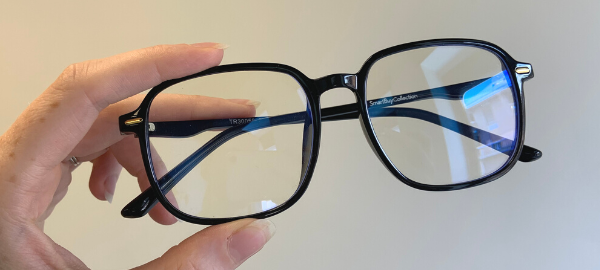
What Is Thyroid Eye Disease?


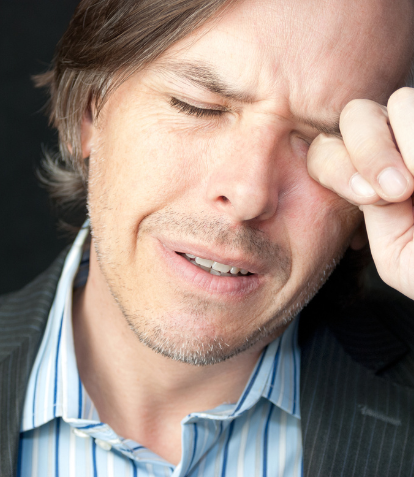
What Is Thyroid Eye Disease?
Thyroid eye disease is a rare disease characterized by progressive inflammation and damage to tissues around the eyes, especially extraocular muscle, connective and fatty tissue. Thyroid eye disease is an autoimmune disorder that may occur in patients who already know they have thyroid disease. This article will cover the primary definition of thyroid eye disease, the symptoms and what treatments are available.
What is thyroid eye disease?
Also known as TED (thyroid eye disease) or Graves’ eye disease, thyroid eye disease is an autoimmune disorder involving an imbalance or recognition problem with your immune system. Most commonly, this happens as part of thyroid disease from an overactive thyroid gland, affecting the skin and eyes. This autoimmune disease causes inflammation and swelling, stimulating the production of muscle tissue and fat behind the eye. Up to one-half of people with Graves’ disease develop these eye symptoms.
Stages of thyroid eye disease
There are two phases of thyroid eye disease. The first is the inflammatory phase which can last from six months to two years, while the second is the stable phase, during which the active inflammation is dormant. Following the inflammatory phase, many individuals are left with eye protrusion, eyelid retraction or double vision, which can be treated in various ways. If you believe you have thyroid eye disease, you must talk to your doctor immediately.
What does thyroid eye disease look like?

Thyroid eye disease symptoms can vary significantly from one person to another. For some individuals, symptoms can lead to pain, disfigurement, or threatened eyesight. For others, the disorder remains unchanged for many years but for others it can either worsen or slightly improve.
Initial symptoms can include:
- • Redness
- • Irritation
- • Discomfort of the eyes and eyelids
- • Dry eyes and pain when moving eyes.
- • Eyelid retraction (the upper eyelid is too high or lower eyelid too low, exposing your eye)
- • Eyes bulging (exophthalmos) or eyes protruding outwards (proptosis) causing a person to look as though they are constantly staring
Additional symptoms can include:
- • Blurred vision
- • Double vision (diplopia)
- • Misalignment of the eyes (strabismus)
- • Chronic bloody eyes
- • White area of eye inflammation
- • Constant watery eyes due to excess tears
- • Swelling around upper or lower eyelids
- • Difficulty looking at bright lights
- • Difficulty moving eyeballs
Progressive swelling can cause increased pressure within the eye socket, headaches and pain. In more severe cases, enlarged eye muscles can compress and cause damage to the optic nerve, which is the main nerve in the eye. As a result, this can progress to cause vision loss over time. Graves thyroid eye disease can also lead to scarring and tissue remodelling around the eyes after inflammation. This can change the eyes’ cosmetic appearance and lead to constantly appearing tired.
If you are experiencing these symptoms, you must seek medical advice from your doctor.
What causes thyroid eye disease?
The underlying process of why thyroid eye disease occurs is not fully understood. The immune system creates an abnormal antibody called thyroid-stimulating immunoglobulin. These abnormal antibodies can affect the cells surrounding your eyes, causing the symptoms associated with the disorder. However, researchers believe people with thyroid eye disease carry the genes for the disorder, activated due to environmental factors. Those who are more at risk of developing the condition include those who:
- • Smoke
- • Have undergone radioactive iodine therapy
- • Have other health conditions that affect the immune system, e.g. diabetes type 1 or rheumatoid arthritis
Thyroid eye disease treatment
Within this section, we have included the various treatments available for thyroid eye disease. However, we recommend you consult your local optician or doctor for professional advice. The below treatments are some of the options you may be provided with from your doctor after diagnosis.
Treating thyroid eye disease requires the coordinated efforts of a team of specialists (ophthalmologists). In recent years, Tepezza® was the first approved drug to help treat thyroid eye disease. Affected individuals have shown significant improvement in double vision and quality of life after taking this thyroid eye disease medication. Another option is to take prescribed steroids (such as hydrocortisone or prednisone) to help reduce the swelling of the eyes from your doctor.
Surgery may be an option for individuals with moderate-to-severe stages of the disease. Surgery tends to be avoided until after the active phase has ended, once inflammation and swelling have reduced. However, surgery may be necessary during the active stage if vision is at risk from the disease.
Orbital Decompression Surgery
The swollen tissues around the eye can compress your main optic nerve. As a result, colour vision becomes abnormal, lights may seem dimmer and vision sharpness decreases. Orbital decompression surgery can help improve your vision by making your eye socket larger or removing excess tissue caused by TED. The surgery can help restore comfort and appearance by reducing the bulging of the eyes. This surgery is typically only given to individuals at risk of vision loss due to pressure on the optic nerve.
Supportive Measures
Some individuals with milder thyroid eye disease can be treated with supportive measures, like dark sunglasses to treat sensitivity to light, artificial tears from your local pharmacy and prisms attached to glasses. When you have thyroid eye disease, your eyes are more sensitive to sunlight and UV rays, so wearing sunglasses helps protect them from the sun and wind.
People with the moderate-to-severe disease may receive corticosteroids, drugs that reduce inflammation and swelling but do not affect diplopia and proptosis. Prednisone is often a common corticosteroid used to treat individuals with thyroid eye disease.
How to reduce swelling from thyroid eye disease?
As well as the above options to treat thyroid eye disease, there are other ways to help reduce swelling. You can try applying cool compresses to your eyes, providing additional moisture and cooling. Try elevating your head when lying down to help reduce swelling and relieve pressure on your eyes. We recommend contacting your doctor if you are experiencing swelling so that you can be given professional advice and prescribed the correct treatment.
Is thyroid eye disease permanent?
Thyroid eye disease is a temporary condition that will eventually fade in time. However, the inflamed period can last from months to years and have a range of impacts on your physical health.
Conclusion
Thyroid eye disease is a treatable problem that usually develops in people with an overactive thyroid caused by Graves’ disease. If you believe you have thyroid eye disease, contact your doctor to receive the best advice on maintaining your eye health.
What Is Thyroid Eye Disease?
Thyroid eye disease is a rare disease characterized by progressive inflammation and damage to tissues around the eyes, especially extraocular muscle, connective and fatty tissue. Thyroid eye disease is an autoimmune disorder that may occur in patients who already know they have thyroid disease. This article will cover the primary definition of thyroid eye disease, the symptoms and what treatments are available.
What is thyroid eye disease?
Also known as TED (thyroid eye disease) or Graves’ eye disease, thyroid eye disease is an autoimmune disorder involving an imbalance or recognition problem with your immune system. Most commonly, this happens as part of thyroid disease from an overactive thyroid gland, affecting the skin and eyes. This autoimmune disease causes inflammation and swelling, stimulating the production of muscle tissue and fat behind the eye. Up to one-half of people with Graves’ disease develop these eye symptoms.
Stages of thyroid eye disease
There are two phases of thyroid eye disease. The first is the inflammatory phase which can last from six months to two years, while the second is the stable phase, during which the active inflammation is dormant. Following the inflammatory phase, many individuals are left with eye protrusion, eyelid retraction or double vision, which can be treated in various ways. If you believe you have thyroid eye disease, you must talk to your doctor immediately.
What does thyroid eye disease look like?

Thyroid eye disease symptoms can vary significantly from one person to another. For some individuals, symptoms can lead to pain, disfigurement, or threatened eyesight. For others, the disorder remains unchanged for many years but for others it can either worsen or slightly improve.
Initial symptoms can include:
- • Redness
- • Irritation
- • Discomfort of the eyes and eyelids
- • Dry eyes and pain when moving eyes.
- • Eyelid retraction (the upper eyelid is too high or lower eyelid too low, exposing your eye)
- • Eyes bulging (exophthalmos) or eyes protruding outwards (proptosis) causing a person to look as though they are constantly staring
Additional symptoms can include:
- • Blurred vision
- • Double vision (diplopia)
- • Misalignment of the eyes (strabismus)
- • Chronic bloody eyes
- • White area of eye inflammation
- • Constant watery eyes due to excess tears
- • Swelling around upper or lower eyelids
- • Difficulty looking at bright lights
- • Difficulty moving eyeballs
Progressive swelling can cause increased pressure within the eye socket, headaches and pain. In more severe cases, enlarged eye muscles can compress and cause damage to the optic nerve, which is the main nerve in the eye. As a result, this can progress to cause vision loss over time. Graves thyroid eye disease can also lead to scarring and tissue remodelling around the eyes after inflammation. This can change the eyes’ cosmetic appearance and lead to constantly appearing tired.
If you are experiencing these symptoms, you must seek medical advice from your doctor.
What causes thyroid eye disease?
The underlying process of why thyroid eye disease occurs is not fully understood. The immune system creates an abnormal antibody called thyroid-stimulating immunoglobulin. These abnormal antibodies can affect the cells surrounding your eyes, causing the symptoms associated with the disorder. However, researchers believe people with thyroid eye disease carry the genes for the disorder, activated due to environmental factors. Those who are more at risk of developing the condition include those who:
- • Smoke
- • Have undergone radioactive iodine therapy
- • Have other health conditions that affect the immune system, e.g. diabetes type 1 or rheumatoid arthritis
Thyroid eye disease treatment
Within this section, we have included the various treatments available for thyroid eye disease. However, we recommend you consult your local optician or doctor for professional advice. The below treatments are some of the options you may be provided with from your doctor after diagnosis.
Treating thyroid eye disease requires the coordinated efforts of a team of specialists (ophthalmologists). In recent years, Tepezza® was the first approved drug to help treat thyroid eye disease. Affected individuals have shown significant improvement in double vision and quality of life after taking this thyroid eye disease medication. Another option is to take prescribed steroids (such as hydrocortisone or prednisone) to help reduce the swelling of the eyes from your doctor.
Surgery may be an option for individuals with moderate-to-severe stages of the disease. Surgery tends to be avoided until after the active phase has ended, once inflammation and swelling have reduced. However, surgery may be necessary during the active stage if vision is at risk from the disease.
Orbital Decompression Surgery
The swollen tissues around the eye can compress your main optic nerve. As a result, colour vision becomes abnormal, lights may seem dimmer and vision sharpness decreases. Orbital decompression surgery can help improve your vision by making your eye socket larger or removing excess tissue caused by TED. The surgery can help restore comfort and appearance by reducing the bulging of the eyes. This surgery is typically only given to individuals at risk of vision loss due to pressure on the optic nerve.
Supportive Measures
Some individuals with milder thyroid eye disease can be treated with supportive measures, like dark sunglasses to treat sensitivity to light, artificial tears from your local pharmacy and prisms attached to glasses. When you have thyroid eye disease, your eyes are more sensitive to sunlight and UV rays, so wearing sunglasses helps protect them from the sun and wind.
People with the moderate-to-severe disease may receive corticosteroids, drugs that reduce inflammation and swelling but do not affect diplopia and proptosis. Prednisone is often a common corticosteroid used to treat individuals with thyroid eye disease.
How to reduce swelling from thyroid eye disease?
As well as the above options to treat thyroid eye disease, there are other ways to help reduce swelling. You can try applying cool compresses to your eyes, providing additional moisture and cooling. Try elevating your head when lying down to help reduce swelling and relieve pressure on your eyes. We recommend contacting your doctor if you are experiencing swelling so that you can be given professional advice and prescribed the correct treatment.
Is thyroid eye disease permanent?
Thyroid eye disease is a temporary condition that will eventually fade in time. However, the inflamed period can last from months to years and have a range of impacts on your physical health.
Conclusion
Thyroid eye disease is a treatable problem that usually develops in people with an overactive thyroid caused by Graves’ disease. If you believe you have thyroid eye disease, contact your doctor to receive the best advice on maintaining your eye health.
Everything You Need to Know About What Causes Bloodshot Eyes
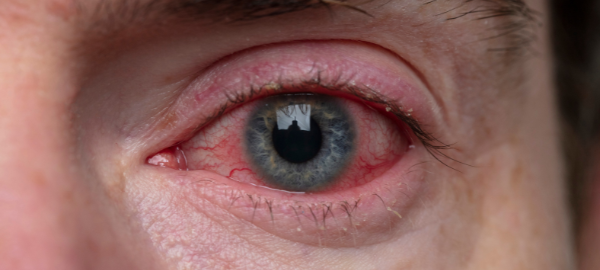

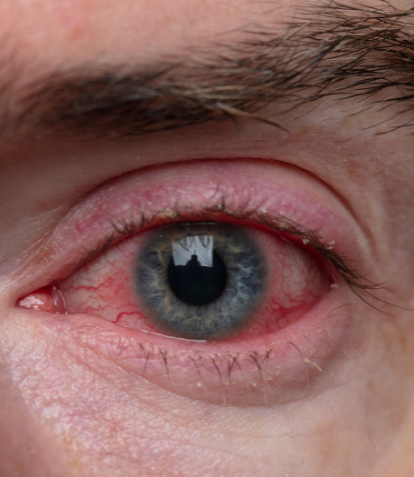
Everything You Need to Know About What Causes Bloodshot Eyes
Do you have sore, irritated, red eyes? Bloodshot eyes, also known as red eyes, can often look worse than they feel and usually go away on their own. The redness occurs when tiny blood vessels under the eye get larger or become inflamed from something irritating your eye. Read on to learn more about this common reaction and the main symptoms, causes and best solutions to help treat bloodshot eyes.
The following symptoms indicate that you have bloodshot eyes:
• Bright red area in the white of your eye – caused by a burst blood vessel (subconjunctival hemorrhage)
• Gritty or burning feeling, sticky eyes – caused by conjunctivitis
• Sore, blurry or watery eyes – caused by dry eyes
• Itchy, painful or red eyelids – caused by Blepharitis
• Feel like there’s something in your eye – caused by an ingrown eyelash or something in your eye causing the irritation
• Swollen, drooping or twitching eyelid or a lump on your eyelid – caused by eyelid issues
Each of these symptoms can give you an idea of what is causing your eye to be red, which we’ll discuss in the next section.
What causes bloodshot eyes?
Red-eye has many different causes. Sometimes it might be that you have left your contact lenses in too long, lack of sleep or have bloodshot eyes from computer usage. Other primary causes of bloodshot eyes are allergies, Blepharitis (inflamed eyelid), conjunctivitis (pink eye), dry eye or glaucoma.
A more severe cause of bloodshot eyes is high blood pressure, but typically there is simply something external irritating your eye. Other causes are inflammation in the middle part of your eye or a blood vessel in your eye that can break from rubbing your eyes too hard. Finally, you may also have an eye injury, corneal ulcers, angle-closure glaucoma, or eyelid stye.
Read below to find out how to treat bloodshot eyes depending on the cause.
How to get rid of bloodshot eyes:
Once you have determined the cause of your bloodshot eyes, you can often treat your bloodshot eyes from home or with over-the-counter treatments.
Bloodshot eyes from allergies
Pollen, certain foods, dust and other foreign substances can cause bloodshot eyes and an itchy sensation. If you think your eyes are red due to allergies, you can take antihistamine eye drops from your local pharmacy. Cool compresses or washcloths on your closed eyes can also provide some relief. We also recommend washing your hands frequently to prevent these allergens from entering your eye if you rub them.
Bloodshot eyes from computer
If you spend a significant amount of time staring at digital screens, then investing in some blue light glasses can help. Wearing these frames while using electronics will help reduce eye irritability, strain, headaches and sleep issues by blocking the harmful blue light.
Bloodshot eyes from dry eye
When your tears don’t lubricate your eyes correctly, they become dry, leading to red and irritated eyes. This can happen when the eyes don’t make enough tears so your eye is not lubricated or nourished, causing dryness. To soothe dry eyes, try over-the-counter eye drops designed to lubricate them. If this does not help, we advise contacting your doctor or optician for alternative treatment.
Bloodshot eyes from contact lenses
If your contact lenses are irritating your eyes and causing inflammation, you need to give your eyes a break from wearing contacts. However, if the issue persists, we recommend switching contact lens brands or wearing glasses more often. This is because you may react to the contact lens material itself or the solution used to clean the lenses. SmartBuyGlasses has a range of prescription glasses for you to choose from if you need a new pair of glasses. In the meantime, you can also try some anti-inflammatory eye drops to ease the irritation.
Bloodshot eyes from Blepharitis
Blepharitis is an eyelid inflammation and a common cause of sore red eyelids or crusty eyelashes. The most effective treatment is over-the-counter lid scrubs. If you suspect you have Blepharitis, contact your doctor.
Bloodshot eyes from Uveitis
If you have inflammation in the middle of your eye, which can lead to eye redness, you may have Uveitis. Other symptoms can include blurred vision, eye pain, eye floaters and sensitivity to light. You must seek medical help to get treatment if you have these symptoms.
Bloodshot eyes from Corneal ulcers
Corneal ulcers are ulcers, or sores, that affect the outer part of your eye, called the cornea. Along with bloodshot eyes, you may feel like there is something in your eye, pus discharge, sensitivity to light, increased tearing and severe eye pain. If this is the case, you must seek timely medical attention as ulcers can permanently damage your eye.
Other bloodshot eye treatments
• You can also try using decongestants to reduce the redness in your eyes. Do not use these drops for more than three days, as long-term use can worsen the redness.
• Dehumidifiers can help absorb the excess moisture in your home, that may irritate your eyes.
• Use clean bedding and towels daily.
• If you suspect you have conjunctivitis, it’s essential to get a diagnosis from a doctor because treatments differ based on the kind of infection.
• Angle-closure glaucoma is when the pressure in your eye increases due to the eye producing more fluid than the average rate. If you have intense pain in your eye, see rainbow-coloured rings or decreased vision, seek medical attention immediately.
How long does it take for bloodshot eyes to go away?
The severity and cause of bloodshot eyes can impact the duration. A burst blood vessel typically lasts only seven to ten days, but if the redness persists, you must seek medical attention. If you continue to be exposed to an allergen or keep wearing your contact lenses, your bloodshot eyes will stay longer. This is why it is crucial to identify the cause.
Can bloodshot eyes be serious?
Often, bloodshot eyes is nothing to worry about and there is likely something irritating your eye. However, sometimes bloodshot eyes can indicate a more serious medical condition, especially if you have any of the following symptoms:
• If your eyes are seeping or crusty, yellow, green or brown mucus, this could be a sign of an eye infection.
• Pain around your eyes
• Unusual sensitivity to light combined with bloodshot eyes
• A fever or sickness combined with bloodshot eyes
• Redness or discomfort that lasts for more than a week and doesn’t respond to home remedies discussed above
If you have any of the above symptoms, we recommend contacting your doctor as soon as possible to avoid worsening the condition.
Conclusion
Bloodshot eyes are a widespread eye problem that is caused by many factors and should go away within a week. If your red eye persists, book an appointment with your doctor to get your eyes checked, as it is likely an eye infection.
When in doubt, always contact your optician or doctor to receive the best advice on how to maintain eye health.
Everything You Need to Know About What Causes Bloodshot Eyes
Do you have sore, irritated, red eyes? Bloodshot eyes, also known as red eyes, can often look worse than they feel and usually go away on their own. The redness occurs when tiny blood vessels under the eye get larger or become inflamed from something irritating your eye. Read on to learn more about this common reaction and the main symptoms, causes and best solutions to help treat bloodshot eyes.
The following symptoms indicate that you have bloodshot eyes:
• Bright red area in the white of your eye – caused by a burst blood vessel (subconjunctival hemorrhage)
• Gritty or burning feeling, sticky eyes – caused by conjunctivitis
• Sore, blurry or watery eyes – caused by dry eyes
• Itchy, painful or red eyelids – caused by Blepharitis
• Feel like there’s something in your eye – caused by an ingrown eyelash or something in your eye causing the irritation
• Swollen, drooping or twitching eyelid or a lump on your eyelid – caused by eyelid issues
Each of these symptoms can give you an idea of what is causing your eye to be red, which we’ll discuss in the next section.
What causes bloodshot eyes?
Red-eye has many different causes. Sometimes it might be that you have left your contact lenses in too long, lack of sleep or have bloodshot eyes from computer usage. Other primary causes of bloodshot eyes are allergies, Blepharitis (inflamed eyelid), conjunctivitis (pink eye), dry eye or glaucoma.
A more severe cause of bloodshot eyes is high blood pressure, but typically there is simply something external irritating your eye. Other causes are inflammation in the middle part of your eye or a blood vessel in your eye that can break from rubbing your eyes too hard. Finally, you may also have an eye injury, corneal ulcers, angle-closure glaucoma, or eyelid stye.
Read below to find out how to treat bloodshot eyes depending on the cause.
How to get rid of bloodshot eyes:
Once you have determined the cause of your bloodshot eyes, you can often treat your bloodshot eyes from home or with over-the-counter treatments.
Bloodshot eyes from allergies
Pollen, certain foods, dust and other foreign substances can cause bloodshot eyes and an itchy sensation. If you think your eyes are red due to allergies, you can take antihistamine eye drops from your local pharmacy. Cool compresses or washcloths on your closed eyes can also provide some relief. We also recommend washing your hands frequently to prevent these allergens from entering your eye if you rub them.
Bloodshot eyes from computer
If you spend a significant amount of time staring at digital screens, then investing in some blue light glasses can help. Wearing these frames while using electronics will help reduce eye irritability, strain, headaches and sleep issues by blocking the harmful blue light.
Bloodshot eyes from dry eye
When your tears don’t lubricate your eyes correctly, they become dry, leading to red and irritated eyes. This can happen when the eyes don’t make enough tears so your eye is not lubricated or nourished, causing dryness. To soothe dry eyes, try over-the-counter eye drops designed to lubricate them. If this does not help, we advise contacting your doctor or optician for alternative treatment.
Bloodshot eyes from contact lenses
If your contact lenses are irritating your eyes and causing inflammation, you need to give your eyes a break from wearing contacts. However, if the issue persists, we recommend switching contact lens brands or wearing glasses more often. This is because you may react to the contact lens material itself or the solution used to clean the lenses. SmartBuyGlasses has a range of prescription glasses for you to choose from if you need a new pair of glasses. In the meantime, you can also try some anti-inflammatory eye drops to ease the irritation.
Bloodshot eyes from Blepharitis
Blepharitis is an eyelid inflammation and a common cause of sore red eyelids or crusty eyelashes. The most effective treatment is over-the-counter lid scrubs. If you suspect you have Blepharitis, contact your doctor.
Bloodshot eyes from Uveitis
If you have inflammation in the middle of your eye, which can lead to eye redness, you may have Uveitis. Other symptoms can include blurred vision, eye pain, eye floaters and sensitivity to light. You must seek medical help to get treatment if you have these symptoms.
Bloodshot eyes from Corneal ulcers
Corneal ulcers are ulcers, or sores, that affect the outer part of your eye, called the cornea. Along with bloodshot eyes, you may feel like there is something in your eye, pus discharge, sensitivity to light, increased tearing and severe eye pain. If this is the case, you must seek timely medical attention as ulcers can permanently damage your eye.
Other bloodshot eye treatments
• You can also try using decongestants to reduce the redness in your eyes. Do not use these drops for more than three days, as long-term use can worsen the redness.
• Dehumidifiers can help absorb the excess moisture in your home, that may irritate your eyes.
• Use clean bedding and towels daily.
• If you suspect you have conjunctivitis, it’s essential to get a diagnosis from a doctor because treatments differ based on the kind of infection.
• Angle-closure glaucoma is when the pressure in your eye increases due to the eye producing more fluid than the average rate. If you have intense pain in your eye, see rainbow-coloured rings or decreased vision, seek medical attention immediately.
How long does it take for bloodshot eyes to go away?
The severity and cause of bloodshot eyes can impact the duration. A burst blood vessel typically lasts only seven to ten days, but if the redness persists, you must seek medical attention. If you continue to be exposed to an allergen or keep wearing your contact lenses, your bloodshot eyes will stay longer. This is why it is crucial to identify the cause.
Can bloodshot eyes be serious?
Often, bloodshot eyes is nothing to worry about and there is likely something irritating your eye. However, sometimes bloodshot eyes can indicate a more serious medical condition, especially if you have any of the following symptoms:
• If your eyes are seeping or crusty, yellow, green or brown mucus, this could be a sign of an eye infection.
• Pain around your eyes
• Unusual sensitivity to light combined with bloodshot eyes
• A fever or sickness combined with bloodshot eyes
• Redness or discomfort that lasts for more than a week and doesn’t respond to home remedies discussed above
If you have any of the above symptoms, we recommend contacting your doctor as soon as possible to avoid worsening the condition.
Conclusion
Bloodshot eyes are a widespread eye problem that is caused by many factors and should go away within a week. If your red eye persists, book an appointment with your doctor to get your eyes checked, as it is likely an eye infection.
When in doubt, always contact your optician or doctor to receive the best advice on how to maintain eye health.
A Guide to Trendy Sunglasses for Face Shapes








































